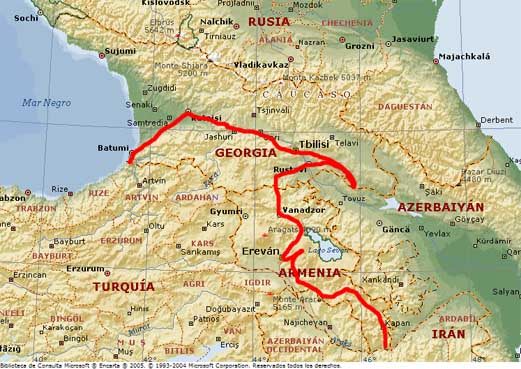| |
en pleno
monte es precioso y además tengo la suerte de que se está
celebrando una boda: son cristianos ortodoxos, como la

gran mayoría de la población de Georgia y Armenia, que constituyen dos
islotes entre poblaciones y países musulmanes. Antes de llegar a Tbilisi
visito el monasterio de Mtsketha, una de las joyas del original arte
georgiano. A pesar de remontarse su construcción al siglo VII, está en
muy buen estado de conservación y su redondeado interior poco tiene que
ver con las construcciones cristianas occidentales, aunque tal vez me
recuerde a los baptisterios arrianos de Ravena. El 19 por la noche, se
está convirtiendo en una costumbre, entro en la capital Tbilisi, y
después de dar unas vueltas con Ibiletxe paro a dormir en una calle del
centro. Me resulta una ciudad agradable, con un |
|
casco antiguo que se me antoja próximo pero algo
deteriorado: bares pequeños y bulliciosos y muchas tiendas de tipo
familiar. Subo en un teleférico a una cercana colina y desde ella puedo
apreciar esta ciudad con sus nuevas y modernas construcciones, y que
pretende ser la gran urbe de esta zona del cáucaso.
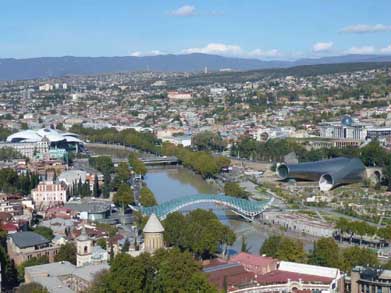
David Gareja
Tbilisi no
está muy lejos de Armenia, pero antes me desvio hacia el norte para
visitar el complejo monacal de David Gareja. Según me voy acercando la
zona se va volviendo más seca, casi desértica y con una carretera que
discurre a veces entre grandes colinas que se asemejan a un paisaje
lunar, a veces entre montañas. Parece que hubiese cambiado de país: tan
distinto es el entorno en el que me encuentro |
|
El
monasterio central de David Gareja está muy bien restaurado, se remonta
al siglo X-XI, pero diseminados entre las rocas hay otros 12 conjuntos
monacales más. Subo al monte cercano en busca de unos frescos de la
época pintados en una cueva, y al cabo de un rato consigo dar con ellos.
Creo que están en la zona de Azerbaiyán, así lo parece indicar unos
postes fronterizos que debo pasar, pero los puedo ver con tranquilidad
pues los soldados georgianos que había en la cumbre ni se molestan en
preguntarme a dónde voy.
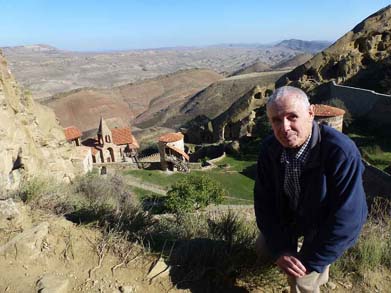
Mientras estoy volviendo atrás para retomar la carretera
principal una vaca me rompe con el rabo el plástico del intermitente, y
es que los rebaños van por el medio de la carretera. Al parecer los
animales consideran que la carretera es |
|
|
| |
tan suya como de los vehículos y esta vez me ha
tocado a mí pagar su mal genio. El día 22 me presento en la frontera de
Armenia, y al igual que a la entrada no tengo ningún problema para salir
de Georgia después de una estancia de 5 días.
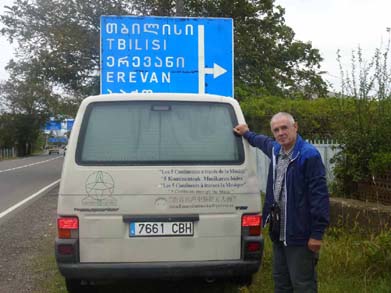
Adiós Georgia
Por fin he podido cumplir el sueño de visitarte. Sentí no poder
hacerlo cuando di la vuelta al mundo por primera vez hace 11 años y me
prometí que lo haría en la próxima. En aquella ocasión varios amigos que
te visitaron me comentaron que la policía dejaba bastante que desear,
pero esta vez no he tenido ningún problema: más bien al contrario lo
cual se agradece. Además los de la unión europea ya no necesitamos visa
y eso también se |
|
agradece. Veo que estás haciendo un gran esfuerzo en
mejorar las infraestructuras, aunque he visto mucha gente marginada que
no lo está pasando muy bien. Y te daría un consejo: procura llevarte
bien con Rusia que al fin y al cabo es tu vecino con el que incluso has
convivido en un mismo país, la URSS, y no escuches los cantos de sirena
que te lanzan los de siempre, y que lo único que buscan es convulsionar
la zona sin importarles que tú sufras las consecuencias. Ya ves los
problemas que tienes en Abjasia y en Osetia y si sigues provocando a tu
vecino por desgracia llevas las de perder. Espero que sepas diferenciar
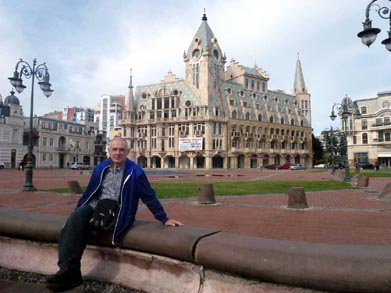
Batumi |
|
entre quién te puede ayudar y quién te utiliza para
sus fines. Suerte.
Armenia
La historia del pueblo armenio es una de las más tristes y
desgraciadas de los últimos tiempos.
Desde siempre ha sido un pueblo emigrante, y a pesar de su pequeñez se
pueden encontrar colonias de armenios en todas partes del mundo. Sin
embargo a finales del siglo XIX y sobre todo principios del XX empiezan
las
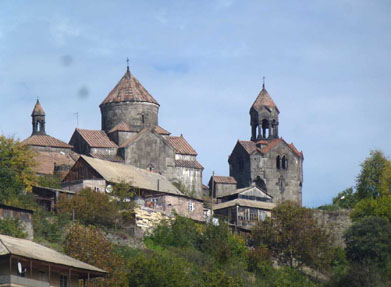
grandes persecuciones y asesinatos de Armenios en el imperio turco que
tenía un porcentaje importante de dicha población, hasta llegar al gran
genocidio de tal vez 1,5 millones de armenios entre 1915 y 1917. Su
población en Turquía prácticamente ha |
|
|
| |
desaparecido, y por
si fuera poco el estado armenio no tiene ningún tipo de relación con dos
de los cuatro países que le rodean: Turquía y Azerbaiyán. La entrada no
es tan sencilla como en Georgia. La visa se consigue en la misma
frontera, así como el
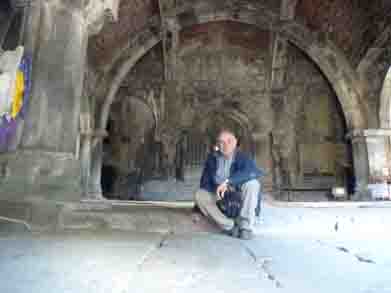
seguro para Ibiletxe, y el papeleo lleva un buen rato. De todas formas
tampoco es barata: 75 euros para los 5 días que pienso estar en el país.
A pocos kmetros de entrar en él veo un aparcamiento en un hotel de
carretera y decido parar para pasar la noche.. Al día siguiente debo dar
media vuelta, pues he dejado atrás dos grandes monasterios.
Haghpat
Está oculto entre montañas, y
según me acerco a el la vista es fascinante. Parece como esos cuentos de
hadas con sus caprichosos palacios. Es un gran complejo monacal del
siglo X y sus redondeadas cúpulas, parecidas a las georgianas, le dan un
|
|
aire muy especial. En
realidad todo en el es especial: el atrio cubierto situado delante de la
iglesia y que arquitectónicamente es muy superior a las construcciones
europeas de la época,, las piedras bellamente labradas, los campanarios
que en algo me recuerdan al románico, en fin algo que también se ha
hecho esperar pero que por fin puedo visitar y disfrutar.
Sanahin
Está a unos kmtros del
anterior, y aunque no tiene su grandeza bien merece una visita Veo mucha
gente entrando a una de las dependencias y me doy cuenta que es un
comedor social: al parecer también aquí hay gente con problemas
económicos.
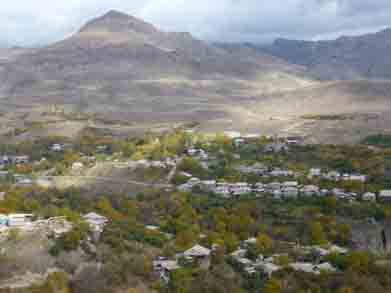
Ambos monasterios están situados en el cañón de Debed por el que paso
camino de Yerevan, la capital. Por la ruta veo varias ciudades con
grandes fábricas abandonadas, vestigios de la pasada URSS. Entro en una
de dichas ciudades a cambiar dinero y la |
|
impresión general es
que tuvieron tiempos mejores.
Haghartsin
Por la tarde entro en un bar a
tomar una cerveza y a cenar y la música armenia ambiental que tienen me
resulta de lo más agradable. Al día siguiente viernes 24 me dirijo al
monasterio de Haghartsin también entre montañas y que es la principal
atracción del pueblo del mismo nombre. Es del siglo XII, situado en una
colina que domina el pueblo y la verdad es que de nuevo me vuelve a
atrapar con su original arquitectura. Deshago el camino para volver a la
carretera principal y pongo rumbo al monasterio de Goshavank: Lo están
reformando y por primera vez pago algo de dinero por entrar a verlo:
Armenia está intentando mejorar la infraestructura turística, y al
parecer no quieren cobrar en los monasterios hasta que la tengan bien
desarrollada.
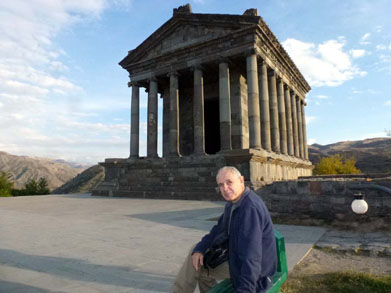
Garni |
|
|
| |
Lago Sevan
Está a unos 180 km de Yerevan y es una de las zonas turísticas de
Armenia.. Paso al lado de el, y a la izquierda una par de pequeñas
iglesias llaman mi atención. Son también muy antiguas, del siglo IX, y
su visión al lado de la orilla del lago es encantadora. Además el sol se
está ocultando y el atardecer es de esos que no se olvidan fácilmente.
Antes de llegar a Yerevan lavo la ropa en
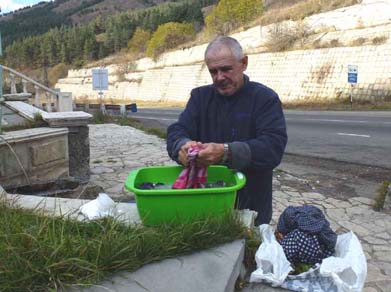
una fuente al lado de la carretera, se para una persona a coger agua y
resulta ser un armenio que habla un castellano-italiano bastante
inteligible. Estamos hablando un rato y me corrobora lo que ya me
imaginaba.
.- En
Armenia hay bastante gente que lo está pasando mal y por si fuera poco
la policía se comporta muy mal con la población--. me dice con cierta
amargura.
La desaparición de la URSS supuso para estas nuevas repúblicas
el colapso industrial, pues el establecimiento de las nuevas fronteras
hizo que las materias
|
|
primas con
las que trabajaban y que llegaban de otras zonas de la URSS se
encareciesen mucho por lo que esas fábricas se hicieron inviables o
demasiado costosas. Es un proceso que ya me ha tocado ver en
Uzbekistán, Tayikistán, Mongolia, donde una pequeña parte de la
población, normalmente ligada al antiguo PCUS, vive muy bien, mientras
la mayoría ha perdido, les han robado, las conquistas sociales que tanto
les costó ganar.
Yerevan
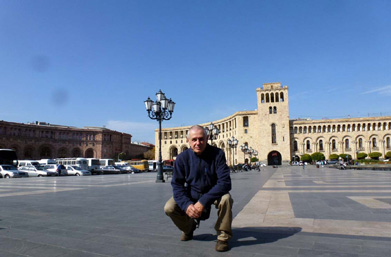
Es con mucho la mayor ciudad
del país, con grandes avenidas y bastante tráfico, pero por lo que veo
no tiene el encanto de Tbilisi. Eso sí tiene metro muy barato y con una
estaciones muy monumentales siguiendo el estilo soviético. De todas
formas a mí me viene muy bien pues me permite desplazarme por la ciudad
con comodidad. El centro está muy arreglado y cuidado, con grandes
edificios buenos restaurantes y tiendas pero me parece que son para los
que son. No puedo decir lo mismo de la zona donde he dejado aparcada Ibiletxe,
con grandes edificios de apartamentos en no muy buenas condiciones. |
|
Garni
No muy lejos de Yerevan hay
dos lugares que quiero visitar: Garni y Gegehard. El primero es un
templo romano, que aunque los hay no son muy frecuentes en esta zona y
el segundo un monasterio. Garni está totalmente reconstruido, y en
verdad que me resulta chocante encontrar en esta zona tal monumento. Es
del siglo I a.c. y está dedicado a Mith dios del sol. Me quedo un buen
rato en el lugar pues merece la pena saborear el paraje privilegiado en
el que se encuentra.
Ya casi de
noche llego a Gegehard y su emplazamiento en plena montaña y al abrigo
de una roca es verdaderamente espectacular. Todo el mundo, hay bastantes
turistas la mayoría locales, están haciendo fotos, pues el lugar lo
merece
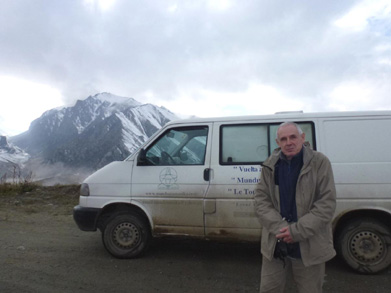
El 26 de octubre tomo dirección Goris, situado a unos 250 km. al
sur y camino de Irán, y debo superar dos grandes puertos a más de 2.000
m de altitud. Armenia aunque pequeña, no llega a los |
|
|
| |
30.000 km2,
es muy montañosa, y tal vez por eso ha conseguido
mantener su cultura, idioma y religión cristiana pero independiente
tanto del vaticano como de la iglesia ortodoxa. Dejo a mi derecha el
monte Ararat, el del arca de Noé, que es todo un símbolo para los
armenios pero que hoy en día se encuentra en territorio turco. A partir
de aquí Armenia se estrecha y va encajonada entre Azerbaiyán a la
izquierda y Naxcivan a la derecha, un enclave que también pertenece a
Azerbaiyán. Al atardecer y cuando estoy atravesando el último puerto
la situación se vuelve complicada pues hay mucha niebla, está nevando,
la noche se me echa encima y la carretera no es ninguna maravilla:
cuatro ingredientes nada recomendables que me hacen circular con mucho
cuidado.
Por fín consigo llegar a Goris
pero estoy tan cansado que lo único que quiero hacer es encontrar un
lugar para aparcar y dormir. Al día siguiente amanezco
con una respetable nevada, pero debo ir al centro pues necesito cambiar
dinero. En Armenia hay bastantes oficinas de cambio, así que no tardo en
encontrar una. No hay mucho que ver en Goris pues es un pueblo grande
pero sin apenas encanto. Sin embargo cerca está el monasterio de Tatev,
que si creo merece la pena.
Tatev
Empiezo a ir a el con
prevención pues está en alto y la nieve caída me da un poco de respeto,
pero aunque la carretera de montaña está francamente mal al menos casi
no tiene nieve. Antes de llegar me encuentro haciendo dedo a un monje
joven de lo más peculiar: a pesar del frío que hace apenas va cubierto
por una túnica y durante todo el camino no deja de cantar en armenio,
supongo. Al llegar al pueblo del mismo nombre que el monasterio se
despide, y yo sigo hasta la entrada de él. Envuelto en la niebla |
|
parece un poco
fantasmagórico y eso unido a la soledad del paisaje le da un carácter
especial. Fundado en el siglo IX, fue uno de los más grandes de Armenia,
llegó a albergar una famosa universidad, y a lo largo de la
historia ha sufrido pillajes y destrucciones siendo reconstruido varias
veces. Rodeado de una gran muralla, soy el único visitante lo cual
agradezco: es todo un lujo pasear entre sus estancias, visitar sus dos
iglesias y observar sus piedras con hermosos dibujos y cubiertas por
todas partes de cruces.
Camino de Irán
Para retomar la carretera
principal que lleva a Irán veo hay una especie de sendero que atraviesa
varios pueblos y que ahorra muchos km. Dudo en tomarlo pues no quisiera
arriesgar a Ibiletxe, pero el afán de aventura se vuelve a imponer sobre
la razón y me lanzo a él. Al principio está embreado, pero pronto se
convierte en un puro camino y además con agua. Son unos 40 km que en
parte los hago con un joven que está haciendo dedo, debo de ir bastante
despacio pero al final consigo llevar a la carretera general. 70 km más
y llego a la frontera con Irán: otra vez el papeleo y el sacarme dinero
con unas tasas de salida que no están nada claras: protesto pero de nada
sirve así que a pagar y a callar. Encima hay que hacerlo en Drams (la
moneda armenia) con lo que debo volver a cambiar dólares. Es curioso que
la última persona que me mira el pasaporte y justo en la salida de
Armenia es una agente rusa, que además lo mira literalmente con lupa!
Adios Armenia
Por fín he podido conocer esos grandes monasterios que tan famosa te
han hecho aunque ya había visto algunos de ellos en Turquía he incluso
en Irán, pues de siempre has sido un pueblo muy emigrante. Debe de haber
una gran desconfianza mutua con |
|
tus vecinos Turquía y
Azerbaiyán para que tengas soldados rusos custodiando tus fronteras,
máxime cuando no tienes siquiera frontera con Rusia. Y lo peor es que el
contencioso con estos dos países parece que no tiene visos de resolverse
en un futuro cercano. Por lo demás los efectos de la desintegración de
la URSS todavía son visibles con tantas fábricas cerradas y lo que es
peor con las diferencias sociales que se van agrandando. Suerte en el
futuro, que te hará falta
Música
Las dos primeras músicas son de
Georgia y la tercera es de Armenia. |
|
|
|
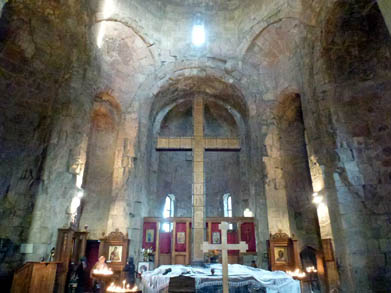 |
|
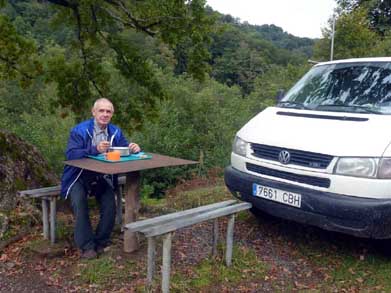 |
|
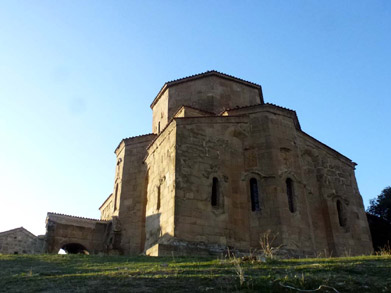 |
|
|
Georgia: monasterio Jikheti
Georgia Georgia: monasterio Jikheti |
|
|
|
|
English |
|
|
|
|
|
Still I am in
my village because of some problems with Ibiletxe, the van, but I hope
everything will be ready for next week.. I have with me a
satellite phone I will conect every saturday from
1p.m. to 2 p.m.
(13-14 hours). The number is: 00870776307176. The cost is 1 Euro/ minute |
|
| |
According
to Greek mythology, in the fourth century B.C. the young Jason
and a handful of brave Greeks, the so named Argonauts for traveling on
a boat called argos , undertook a dangerous and long journey to the
distant kingdom of Colchis, where his mighty king Eedes, kept his prized
"Golden Fleece" ( a sheepskin-lined gold) guarded by a fierce dragon.
After several years of travel and many problems they got the Fleece and
returned to Greece. This kingdom of Colchis is usually placed on the
west coast of Georgia, and so far I have come to admire their particular
"golden fleeces" embodied in their mythical monasteries and medieval
towns.
After 2 hours 'lost' in the Turkish border I enter with some prevention
in Georgia, but my fears are unfounded. The border crossing is very fast
because I do not need visa, they do not even look Ibiletxe, and in less
than five minutes I'm inside the country. It seems things have changed
a lot since the references I had were nothing good in regard to police
behavior: this change is welcome.
I quickly take towards Batumi, the second Georgian city in the black
sea, where I arrive the October 17th. It is night, hardly any traffic
and dedicate myself to a few laps with Ibiletxe. There is a marked
contrast between the center fairly well kept with beautiful illuminated
buildings, and the part not centrally located with large potholes in the
streets, dirty buildings and low lights. Encounter a bureau de change
and after I drink a good beer in a bar: on the top floor they have a
small disco that looks like a kindergarten.
Next
day I devote myself to go walking the city center and I find it
amazingly beautiful. The new buildings contrast with the stately
buildings of the XIX-XX century, with the charm that often have cities
with seaport. I can see that Batumi has been in the past a |
|
city with a certain wealthy population.
.- This part of town is very beautiful-. I say to a person who help me
to take a photo.
.- Yes but there are many people that are going very badly in Georgia-.
He answer with some bitterness.
I
go towards Kutaisi, and halfway I detour to see the monastery of
Jikheti. Although in its origins very old now has been fully rebuilt,
but the way to it is a trail in the bush very beautiful, and I´m very
lucky because they are celebrating a Christian Orthodox wedding. Most of
the population of Georgia and Armenia are Christian Orthodox and they
are like two islets between Muslim population.
Before arriving to Tbilisi I visite the monastery of Mtsketha, one of
the jewels of the primitive Georgian art. Although its construction date
back to the seventh century, is in very good condition and its rounded
inside has little to do with Western Christian buildings, but perhaps
remind me of Arrian baptistery in Rabena.
The 19th by night, it is becoming a habit, enter the capital
Tbilisi, and after a few laps with Ibiletxe stop to sleep in a downtown
street. I find it a pleasant city with an old town which I find nice but
somewhat deteriorated with small and bustling bars and many family
shops. I climb on a cable car to a nearby hill and from there I can
appreciate this city with its new and modern constructions: Tbilisi
intends to be the great city of this Caucasus area
Tbilisi
is not far from Armenia, but before going there I make a detour
north to visit the monastic complex David Gareja. As I'm approaching the
area it gets more dry, almost deserted going through a road that runs
between large hills: sometimes resemble a lunar landscape. It seems that
I´m in another country: so different is the environment in which I find
myself. The central monastery
of David Gareja beautifully restored, dates back to the X-XI century,
but scattered among rocks there are 12 other monastic |
|
complex. I
climb the nearby mountain in search of frescoes of that time painted in
some caves, and after a while I get to find them. I think they are in
the area of Azerbaijan, as some border posts suggest, but I can see them
calmly as Georgian soldiers in the summit did not bother to ask me where
I was going.
While I'm going back to retake the main road a cow breaks one of the
tail plastic intermittent, as the flocks go in the middle of the road.
Apparently the animals feel the road is theirs as well, and this time I
had to pay for their bad temper. On the day 22th I arrive to the
border of Armenia, and like the entrance I have no problem to leave the
country after a stay of five days.
Goodbye Georgia
I've
finally been able to fulfill the dream of visiting you. I felt
unable to do so when I turned around the world for the first time 11
years ago and I promised I would do next time. On that occasion several
friends who visited you told me that the police left much to be desired,
but this time I had no problem: rather the opposite which is
appreciated. In addition, the people from the European Union no longer
need visa and that too is appreciated. I see you are making a great
effort to improve infrastructure, although I have seen a lot of
marginalized people that are not going well. And I would give you an
advise: try to get along with Russia that after all is your neighbor,
with whom you have even lived in the same country the USSR, and not
listen to the siren song of the usual countries, you know: all they want
is convulsing the area and they don´t care you suffer the consequences.
You see the problems you have in Abkhazia and Ossetia and if you
continue like that with your neighbor unfortunatly you are going to
lose. I hope you differentiate among who can help you and who only wants
to use you: good luck |
|
|
| |
Armenia
The history of the Armenian people is one of the saddest and most
unfortunate of recent times. It has always been an emigrant people and
despite its smallness can be found colonies of Armenians all over the
world. However in the late nineteenth and early twentieth mostly, began
the great persecutions and killings of Armenians in the Ottoman Empire:
perhaps more than 1.5 million Armenians between 1915 and 1917were
murdered. Its population in Turkey has practically disappeared, and last
but not least the Armenian state does not have any relationship with two
of the four countries surrounding him Turquía and Azerbaijan.
Admission is not as simple as in Georgia. The visa is obtained at the
border, as well as insurance for Ibiletxe, and paperwork takes a while.
Anyway it is not cheap: 75 euros for the 5 days I´m going to be there.
After a few kmetros I see a car park at a roadside hotel and decided to
stop for the night . The next day I turn around, because I've left
behind two large monasteries.
Haghpat
It is hidden in the mountains, and as I approach the view is
fascinating. Looks like those fairy tales with their whimsical palaces.
It's a great monastic complex of Xth century, and rounded domes similar
to the Georgian, give a very special atmosphere. Actually everything is
special: the covered atrium in front of the church, the rounded church
and the beautifully carved stones, the bell
tower
that somehow reminds
me of the Romanesque. Architecturally the construction is superior to
the European constructions of that
time.
Sanahin
It is situated a few kilometer from Haghpat, and although it has not
its grandeur well worth a visit I see many people coming to one of the
outbuildings and I realize it is a social dining room: apparently there
are people with financial problems.
Both |
|
monasteries are located in
the canyon of Debed in the way to Yerevan, the capital. On the road I
see several cities with large abandoned factories, vestiges of the
Soviet past. I go into one of
those cities to change money and the overall
impression is that they had better times.
In the afternoon I walk into a bar for a beer and dinner and the
Armenian background music is most enjoyable. The next day Friday 24th
visit the monastery of Haghartsin also among mountains, and is the main
attraction of the village of the same name. It is from the twelfth
century, situated on a hill overlooking the village and again its
original architecture catch my attention. Back to the main road and get
direction to the monastery of Goshavank: They are reforming it and for
the first time I pay some money in order to see it: Armenia is trying to
improve tourism infrastructure, and apparently they do not want to
charge until they have well developed it.
Lake Sevan
It
is about 180 km from Yerevan and is one of the tourist areas of
Armenia.
The road is passing near by, and on
the
left a couple of small
churches call my attention. They are also very old, from the IXth
century, and his vision lakeside really is lovely. Also the sun is
setting and the sunset is one of those that are not easily forgotten.
Before arriving to Yerevan I wash my clothes in a fountain next to the
road. A person approaching to take water stops, and turns out to be an
Armenian who speaks quite intelligible
Italian-Castilian. We talk for a
while and he corroborates what I already imagined:
.- In Armenia there are many people who are going through a very bad
situation, and the trafic police behaves quite badly with the population -.
says with some bitterness.
The disappearance of the USSR led to the industrial collapse of those
new republics, since the establishment of the new frontiers made raw
materials coming from other areas of the USSR too costly. It is a
process that I had already seen in Uzbekistan, |
|
Tajikistan, Mongolia, where a small part of the population, usually
linked to former CPSU, live well, while the most lost nearly all the
social advantages they had won with the time.
Yerevan
It
is by far the largest city, with wide avenues and enough traffic, but
what I see does not have the charm of Tbilisi. Yerevan have very cheap
metro with monumental stations following the Soviet style. The
center is well groomed and maintained with large buildings good
restaurants and shops but I think they are only for the whealthy people.
Where I left parked Ibiletxe is not the same: is a poor area
with the buildings in not very good condition.
Garni
Not far from Yerevan there are two places I want to visit: Garni and
Gegehard. The first is a Roman temple, although they are not very common
in this area, and the second is a monastery.
Garni has been completely rebuilt, and surely is really shocking to find
such monument here. It's from the first century a.c. and is dedicated
to the sun god Mith.
Almost
night I get to Gegehard and its location in the mountains protected by a
rock is truly spectacular. There are a lot of local tourists taking
pictures, because the place deserves it
The October 26 I take direction to Goris, located about 250 km south in
the way to Iran, and I must overcome two major ports over 2,000 m
altitude. Armenia although small, has less than 30,000 km2, is very
mountainous, and maybe that helped to maintain their culture, language
and Christian religion, but independent of both the Vatican and the
Orthodox Church. On my right I pass Mount Ararat, the place of Noah's
ark, which is a symbol for Armenians, but today is in Turkish territory.
From here Armenia narrows sandwiched between Azerbayan, on the left,
and Naxcivan on the right, an enclave that also belongs to Azerbaijan.
At dusk and when I'm going through the last port the situation becomes
complicated because there are a lot of fog, |
|
|
|
is
snowing,
night comes down
and the road is not good at all: four
ingredients that make me
drive very
carefully.
Goris
At
last I get to Goris but I'm so tired that all I want to do is find a
place
where
to park and sleep.
The next day I wake up with a respectable snow, but I go downtown
because I need to change money. In Armenia there are many exchange
offices, so does not take long to find one. There is
not much to see in
Goris as it is a large town but with little charm. But is the nearby
monastery of Tatev that I think worth it.
Tatev
When I start going there I have some prevention because of the fallen
snow, but though the mountain road is really bad at least there is not
much snow. Before arriving I find a very peculiar young monk hitching.
Despite the cold weather goes barely covered by a robe and all the way
is singing in Armenian, I guess. After reaching the village of the
same name than the monastery |
|
we say goodbye, and I continue to the near monastery.
Shrouded in fog seems a little spooky, and the loneliness of the
landscape gives to the monastery a special character. Founded in the
ninth century, was one of the largest in Armenia and came to house a
famous university, but throughout history has suffered looting
and
destruction being rebuilt several times.
Surrounded by a great wall, I am the only visitor and I appreciate it:
is a luxury walk among their stays, visit its two churches and observe
the stones covered with beautiful drawings of crosses everywhere.
In my way to Iran
For
returning to the main road going to Iran I see there is a kind of
trail through several villages which saves many miles. I hesitate to
take it because I would not want to risk Ibiletxe, but the desire for
adventure reimposes
on reason and strain toward him. At first it is
tarred, but soon becomes a pure way and also with water. They are about
40 km that I do in part with a young man going from one village
to another. I must go quite slowly but eventually
|
|
get out
to
the main road. 70 more miles and come to the border with Iran and again
a lot of paperwork and money to pay which is not clear at all: I protest
but there is nothing to do but pay. Besides I have to pay in Drams
(Armenian currency) so I have to change some dollars. It is curious that
the last person to see my passport, literally with a magnifying glass,
and just off Armenia is a Russian agent.
Music
The two
first songs are from Georgia and the third one is from Armenia. |
|
|
|
|



